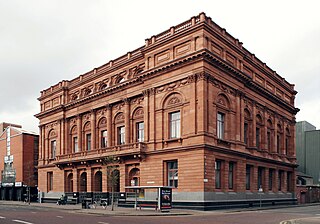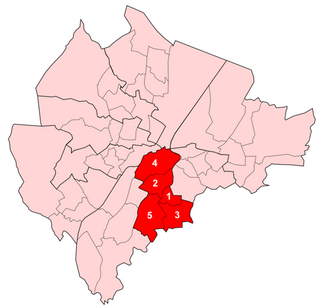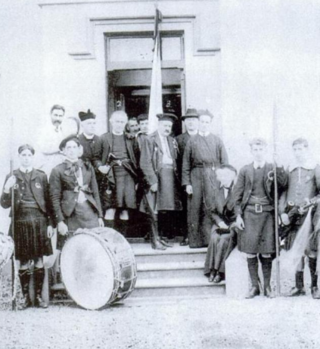
Belfast is the capital and largest city of Northern Ireland, standing on the banks of the River Lagan on the east coast. It is the 10th-largest primary urban area in the United Kingdom and the second-largest city in Ireland. It had a population of 345,418 in 2021.

Seamus Justin Heaney was an Irish poet, playwright and translator. He received the 1995 Nobel Prize in Literature. Among his best-known works is Death of a Naturalist (1966), his first major published volume. Heaney was and is still recognised as one of the principal contributors to poetry in Ireland during his lifetime. American poet Robert Lowell described him as "the most important Irish poet since Yeats", and many others, including the academic John Sutherland, have said that he was "the greatest poet of our age". Robert Pinsky has stated that "with his wonderful gift of eye and ear Heaney has the gift of the story-teller." Upon his death in 2013, The Independent described him as "probably the best-known poet in the world".

The National Library of Ireland is the Republic of Ireland's national library located in Dublin, in a building designed by Thomas Newenham Deane. The mission of the National Library of Ireland is "To collect, preserve, promote and make accessible the documentary and intellectual record of the life of Ireland and to contribute to the provision of access to the larger universe of recorded knowledge."
Benburb ) is a village and townland in County Tyrone, Northern Ireland. It lies 7.5 miles from Armagh and 8 miles from Dungannon. The River Blackwater runs alongside the village as does the Ulster Canal.
Belfast City Centre is the central business district of Belfast, Northern Ireland.

The Belfast Natural History and Philosophical Society was founded in 1821 to promote the scientific study of animals, plants, fossils, rocks and minerals.

Belfast City Hall is the civic building of Belfast City Council located in Donegall Square, Belfast, Northern Ireland. It faces North and effectively divides the commercial and business areas of the city centre. It is a Grade A listed building.

Belfast Central Library is a public library in Royal Avenue, Belfast, Northern Ireland. Opened in 1888, it was one of the first major public library buildings in Ireland.

Donegall Square is a square in the centre of Belfast, County Antrim, Northern Ireland. In the centre is Belfast City Hall, the headquarters of Belfast City Council. Each side of the square is named according to its geographical location, i.e. Donegall Square North, South, East and West. It is named after the Donegall family. Other streets to bear their name in Belfast are Donegall Road, Donegall Pass and Donegall Street. Donegall Place, the city's main shopping street, runs from the north side of the square.
The Belfast Harp Festival, called by contemporary writers The Belfast Harpers Assembly, 11–14 July 1792, was a three-day musical and patriotic event organised in Belfast, Ireland, by leading members of the local Society for Promoting Knowledge : Dr. James MacDonnell, Robert Bradshaw, Henry Joy, and Robert Simms. Edward Bunting, a young classically trained organist, was commissioned to notate the forty tunes performed by ten harpists attending, work that was to form the major part of his General Collection of the Ancient Irish Music (1796). The venue of the contest was in The Assembly Room on Waring Street in Belfast which was opened as a market house in 1769.

The Donegall Road is a residential area and road traffic thoroughfare that runs from Shaftesbury Square on what was once called the "Golden Mile" to the Falls Road in west Belfast. The road is bisected by the Westlink – M1 motorway. The largest section of the road, east of the Broadway junction with the Westlink, has a community which self-identifies as predominantly Protestant while the community on the other side of the Westlink – M1 motorway self-identifies as predominantly Catholic.

The Cathedral Quarter in Belfast, Northern Ireland, is a developing area of the city, roughly situated between Royal Avenue near where the Belfast Central Library building is, and the Dunbar Link in the city centre. From one of its corners, the junction of Royal Avenue, Donegall Street and York Street, the Cathedral Quarter lies south and east. Part of the area, centred on Talbot Street behind the cathedral, was formerly called the Half Bap. The "Little Italy" area was on the opposite side of Great Patrick Street centred on Little Patrick Street and Nelson Street.

John Harold Hewitt was perhaps the most significant Belfast poet to emerge before the 1960s generation of Northern Irish poets that included Seamus Heaney, Derek Mahon and Michael Longley. He was appointed the first writer-in-residence at Queen's University Belfast in 1976. His collections include The Day of the Corncrake (1969) and Out of My Time: Poems 1969 to 1974 (1974). He was also made a Freeman of the City of Belfast in 1983, and was awarded honorary doctorates by the University of Ulster and Queen's University Belfast.
The subdivisions of Belfast are a series of divisions of Belfast, Northern Ireland that are used for a variety of cultural, electoral, planning and residential purposes.

The buildings and structures of Belfast, Northern Ireland comprise many styles of architecture ranging from Edwardian through to state-of-the-art modern buildings like the Waterfront Hall. The city's beautiful Edwardian buildings are notable for their display of a large number of sculptures. Many of Belfast's Victorian landmarks, including the main Lanyon Building at Queens University in 1849, were designed by Sir Charles Lanyon.

The Linen Quarter is a vibrant area of Belfast city centre. The name is derived from the great many linen warehouses that are still present in the area. The Linen Quarter is host to some of the major cultural venues of Belfast, including the Ulster Hall and Grand Opera House, alongside a large number of hotels, bars, restaurants and cafes. The district also includes the main transport hub of Belfast.

Laganbank was one of the nine district electoral areas in Belfast, Northern Ireland which existed from 1985 to 2014. Located in the south of the city, the district elected five members to Belfast City Council and contained the wards of Ballynafeigh, Botanic, Shaftesbury, Stranmillis, and Rosetta. Laganbank, along with neighbouring Balmoral, formed the greater part of the Belfast South constituencies for the Northern Ireland Assembly and UK Parliament.

The North Street Arcade is a 1930s Art Deco shopping arcade in the Cathedral Quarter of Belfast, Northern Ireland. It is the only example of a shopping arcade from this decade in Northern Ireland, and is one of only a handful left in the whole of the UK. A Grade B1 listed building, it has been derelict since a fire in 2004.

Francis Joseph Bigger was an Irish antiquarian, revivalist, solicitor, architect, author, editor, Member of the Royal Irish Academy, and Fellow of the Royal Society of Antiquaries of Ireland. His collected library, now distributed across several public institutions, comprised more than 18,000 books, journals, letters, photographs, sketches, maps, and other materials. His house in Belfast was a gathering place for Irish nationalist politicians, artists, scholars, and others. He was a prolific sponsor and promoter of Gaelic culture, authored many works of his own, founded several institutions, and revived and edited the Ulster Journal of Archaeology.

The Belfast Harp Society (1808-1813) and its successor, the Irish Harp Society (1819-1839), were philanthropic associations formed in the town of Belfast, Ireland, for the purpose of sustaining the music and tradition of itinerant Irish harpists, and secondarily, of promoting the study of the Irish language, history, and antiquities. For its patronage, the original society drew upon a diminishing circle of veterans of the patriotic and reform politics of the 1780s and '90s, among them several unrepentant United Irishmen. In its sectarian division, Belfast became increasingly hostile to Protestant interest in distinctive Irish culture. The society reconvened as the Irish Harp Society in 1819 only as a result of a large and belated subscription raised from expatriates in India. Once that source was exhausted, the new society ceased its activity.




















